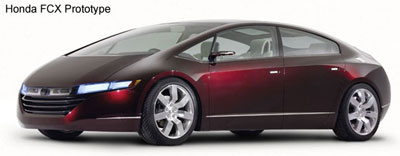Introduction
For thousands of years,
propulsion for personal transportation was provided by a beast of burden hitched to a wooden wagon or sled. Then, about a
hundred years ago, someone got the bright idea to attach a
new-fangled contraption called the "internal combustion engine" to
that wagon, creating "the horseless carriage." And so the
automotive industry was born and with it came ongoing improvements
to the piston-driven internal combustion engine until it evolved
into the incredible, fuel-efficient, power plant that propels our
modern vehicles. Yet, refinements aside, the governing
principles behind the basic functioning of the typical modern
automotive engine are identical to those of the Model-T Ford.
It is not that we haven't tried to come up with
alternatives to the piston engine. We have developed numerous systems. In fact, electric cars have been around for as long
as the piston engine. We have also tried steam, gas turbines,
rotary engines and solar powered cars. But none of these could
rival the power and efficiency of the internal combustion piston
engine, fed by fossil fuel and connected to a transmission that
turns the drive wheels through a series of shafts and gears.
Unfortunately, nagging problems like fuel shortages
and air pollution necessitate a renewed search for alternative power sources for our personal transportation needs. While
engineers have been ingenious in proposing new ideas for propulsion systems that are far more efficient than anything that we have
today, the problem is that most of these technologies rely on fuels
other than gasoline and there is no system in place to deliver these
fuels to us at anything close to the price that we now pay for gas.
Can we build an infrastructure to deliver a better
fuel, whatever it may be? Probably. But who will build
it? The oil companies say that they will build such a system
as soon as there are enough cars to make it profitable, but who will buy one of these cars before the required fuel is available?
It's the classic catch-22.
Government intervened in California by requiring a
percentage of cars sold to be zero-emission vehicles by a specified
date. The only currently available technology that could meet
the zero emissions goal was an electric car, so manufacturers
dutifully designed and built electric cars for sale in California
and even subsidized the cost of these vehicles to make them
attractive for consumers. The program was a dismal
failure. Few people wanted to bear the inconvenience of a car
with a range of less than 100 miles, after which they had to plug it
into an outlet for hours of recharging. The answer looked like
it might have to to come from some kind of liquid or gaseous fuel
that could be dumped into a vehicle in minutes and provide a range
of a few hundred miles before the process had to be repeated. So
we're back to the catch-22.
There is a partial answer to this conundrum available
today in the form of an innovative technology that uses existing
fuel supplies more efficiently. This promising technology
combines a gasoline engine with an electric motor to stretch a
gallon of gas further than ever before possible. The vehicles
that use this technology are called Hybrids because they use a
combination of a very efficient gasoline engine and a hi-tech
electric motor to propel the vehicle.
The Concept: How the hybrid system works in simple terms
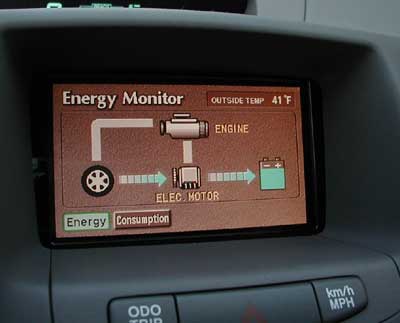 Despite the fact that they
use electric motors that draw their power from a battery, hybrid
vehicles do not have to be plugged in to recharge... Ever. The battery is recharged from two sources, and herein lies this system's
advantage. The first source is from a generator powered by the
internal combustion engine. The second source is through
reclaiming the energy that is normally wasted slowing and stopping
the vehicle. Let's look at the second method first because
that is the most intriguing.
Despite the fact that they
use electric motors that draw their power from a battery, hybrid
vehicles do not have to be plugged in to recharge... Ever. The battery is recharged from two sources, and herein lies this system's
advantage. The first source is from a generator powered by the
internal combustion engine. The second source is through
reclaiming the energy that is normally wasted slowing and stopping
the vehicle. Let's look at the second method first because
that is the most intriguing.
When you step on the brakes to slow a vehicle, you are
counteracting the energy of a one or two ton projectile that wants
to keep going because of inertia. In order to slow the
vehicle, you must convert the energy of inertia into a different
form: heat. The brakes heat up, absorbing the energy of the speeding
vehicle, and the air that is directed around them then dissipates
the heat, carrying it into the surroundings.
Many of us complain about how much it costs to
heat a house, but here we are throwing all of our braking energy to
the wind. What if we could capture some of that energy and use
it later on to propel the vehicle? Well, that is exactly what
a hybrid vehicle does. It uses a property that is
inherent in all electric motors: the fact that electric motors and
generators are exactly the same. If you send electricity
through wires into a motor, it will cause the shaft of the motor to
turn, but if you find another way to turn the shaft of an electric
motor, it will generate electricity back through those wires.
The more work that a motor has to perform, the more
electricity it requires. In the same way, the more electrical
power you demand of a generator, the harder it is to turn the shaft. So, if we set the system up so that when you first step
on the brakes, it connects this motor/generator to the battery in
order to charge it, the effect will be to slow the vehicle down and,
voila, we have free energy that we just stored in the battery to be
used later to propel the car.
On the other side of the equation, the gasoline engine
can be smaller because, when it needs extra power, the electric
motor is there to assist in the acceleration using the free energy
in the battery that was captured the last time that the brakes were
applied. Because the engine doesn't have to be as powerful, it
can be more compact and deliver much better gas mileage.
The Cars: What it's
like to drive them
As of this writing, there are two,
very affordable vehicles that you can buy that use hybrid
technology, the Toyota Prius and the Honda Insight, with several
more on the way.
The Toyota Prius, which is a 4-door, 5-passenger sedan, gets an EPA rating of 52 mpg city and 45 mpg highway while
the Honda Insight, a small 2-passenger coupe gets 61 mpg city and 68
mpg highway. In the spring of 2002, you will also see a new
Honda Civic hybrid that will match the 4-door 5-passenger layout of
the Prius. The powertrain layout for the new Civic will be similar to the Insight. Ford will join the fray in 2003 with a
hybrid version of the Escape SUV.
These cars are also environmentally friendly. Both the
Prius and the Insight with the CVT (Automatic) transmission have
earned an SULEV emissions rating. This means that if you were
able to collect all the pollution that was emitted from one of these
cars over 100,000 miles, you would just about fill a tea
cup.
The Prius:
Three components make up the
power train of the Prius, a 4 cylinder high efficiency gasoline
engine, a generator and an electric motor. These components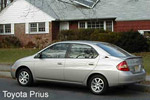 are tied
together with a single planetary gear set. There is no transmission beyond that simple gear arrangement.
are tied
together with a single planetary gear set. There is no transmission beyond that simple gear arrangement.
To start the Prius, you turn the ignition switch
to the start position, just like a normal car, but you don't hear
anything. Did the car start? The indicators on the
graphical display panel say that the car is running, but there is silence. Ok, on a leap of faith you put the Selector Lever in
Drive and step on the accelerator pedal and, sure enough, the car
takes off silently as though a large invisible hand is pushing you
from behind.. As you reach about 15 mph, you notice that the
gasoline engine is running though you did not hear it start.
During normal cruising above 15 mph, the gasoline
engine is doing most of the work while the generator tops off the
charge in the battery. Whenever you release the throttle or step on the brake, the electric motor doubles as a generator and
charges the battery through regenerative braking. If more
power is needed for accelerating or climbing a hill, the electric
motor immediately kicks in to assist the gasoline engine using the
energy that is stored in the battery. As you slow down and
come to a stop, you realize that the gasoline engine is no longer
running and the car is dead quiet, an eerie feeling that would have
you breaking out into a cold sweat in an ordinary car.
Another thing that you notice as you accelerate is
that this car does not shift. The planetary gear set acts as
an infinitely variable transmission that gradually transitions from
low gear to high gear in a smooth steady flow. The effect is
that, while the car picks up speed, the engine seems to stay at its
most efficient rpm.
Backing up is handled completely by the electric motor
which serves to simplify the system and eliminate the need for a
reverse gear.
The Prius rides and handles
like a typical Toyota Corolla, which is to say, competently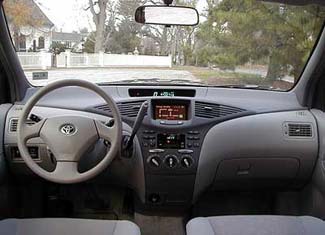 .
The exterior is about the size of a Corolla as well. Interior space, however, is more like that of a Camry with plenty of room for
5 adults to ride in comfort. There is also a reasonably sized
trunk, despite the fact that there is a pretty large battery pack
hidden back there.
.
The exterior is about the size of a Corolla as well. Interior space, however, is more like that of a Camry with plenty of room for
5 adults to ride in comfort. There is also a reasonably sized
trunk, despite the fact that there is a pretty large battery pack
hidden back there.
The Toyota Prius is an environmentally friendly family sedan, that is quite pleasant to drive and easy to live with.
Acceleration is a bit leisurely for some of the more aggressive
drivers that I know, but it is competent and will handle most
traffic situations without a problem
The brake feel takes a bit of getting used to.
The car stops well, but the brake pedal feel is unusual. On a
normal car, the harder that you press on the brake pedal, the stronger the stopping action, but on the Prius, a light pressure on
the brake will start with a light braking action that increases in severity even though pedal pressure hasn't changed. I'm not saying that this a safety issue at all, more of an
idiosyncrasy. You will adapt to it after a while and learn to
compensate until you barely notice it.
The Insight:
The Honda Insight is a small two seat
commuter car that gets great gas
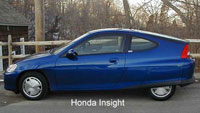 mileage and is a blast to drive and be seen in. It weighs in at a featherweight 1,887 pounds due
to a lightweight aluminum body and frame that is 47-percent lighter
than an equivalent steel body. Powering the Insight is a 1.0 liter,
3-cylinder VTEC engine coupled to an ultra-thin electric motor that
is mounted between the engine and the transmission. The
electric motor provides additional power to help the engine when
it's needed during acceleration. When slowing down, the motor
does double duty as a generator to recharge the battery pack.
This "regenerative braking" captures energy that is normally lost
through the brakes and stores it in the battery for later use to
help propel the car.
mileage and is a blast to drive and be seen in. It weighs in at a featherweight 1,887 pounds due
to a lightweight aluminum body and frame that is 47-percent lighter
than an equivalent steel body. Powering the Insight is a 1.0 liter,
3-cylinder VTEC engine coupled to an ultra-thin electric motor that
is mounted between the engine and the transmission. The
electric motor provides additional power to help the engine when
it's needed during acceleration. When slowing down, the motor
does double duty as a generator to recharge the battery pack.
This "regenerative braking" captures energy that is normally lost
through the brakes and stores it in the battery for later use to
help propel the car.
Unlike the Prius, the Insight has a transmission,
either a 5-speed manual or, for 2002, a new CVT automatic, and
drives like a normal economy car. The engine is always running
when the vehicle is moving, but will sometimes shut itself off when
you stop in order to conserve fuel. As soon as you depress the
clutch, the engine instantly restarts. The single electric
motor is used as an assist to the 3 cylinder gasoline engine, which
is the primary source of power. The electric motor becomes a
generator when the computer calls upon it to charge the battery.
This system is elegant in its simplicity and certainly
delivers the goods with an EPA rating of 61 mpg city and 68 mpg
highway for the standard transmission model. These
figures earn the Insight top billing as the most fuel efficient car sold in America. The CVT Equipped Insight comes in at a
respectable 57 mpg city and 56 mpg highway.
During my week-long test
drive of the stick-shift model,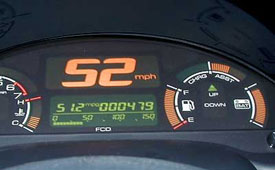 I rarely drove it like an economy
car in my quest to find its performance potential. I was
surprised by the better than 50 mpg average that this car delivered
despite all the flogging.
I rarely drove it like an economy
car in my quest to find its performance potential. I was
surprised by the better than 50 mpg average that this car delivered
despite all the flogging.
Despite the great gas mileage, this car has good
acceleration and is as much fun to drive on winding country roads as
it is to dart around in city traffic.
There is only room in this car for two people and
their bare essentials since there is very little storage space. As is typical for Honda, the handling and steering feel
are excellent. The ride is another story, however. You
will feel all the bumps and irregularities of the road surface as
you drive this featherweight. Part of the reason for the choppy ride
is the small, high-pressure tires that are tailored for the lowest
rolling resistance possible.
If you are looking for a commuter car that won't break
the bank, look no further. This is your puppy. If you
like Honda but need a car that has more room, a new Civic Hybrid is
just around the corner. The Honda Civic Hybrid has a new
1.3-liter i-DSI 4-cylinder engine and more advanced version of the
Integrated Motor Assist (IMA) system that powers the Insight. Gas
mileage is expected to be around 50 MPG for both city and highway
driving and there will be room for 5.
The Nuts &
Bolts:
How the hardware works in
technical detail
The technology that allows these two cars to
get this kind of efficiency is impressive.
The Toyota Prius:
The components that are used to perform this magic on the
Toyota Prius include: a 4 cylinder high efficiency gasoline engine
and two combination generator/motors. One is mounted to the
gasoline engine where the flywheel normally sits. Toyota calls this
one a generator although it also serves as a starter motor.
The other motor is connected to the drive wheels and is used to move
the car at low speeds and assist the engine when more power is
required. This motor does double duty as a generator whenever
the car is coasting or slowing down. All three components
(gasoline engine and 2 motor/generators) are connected through a
planetary gear set. There is also a 274 volt nickel-metal
hydride battery that is mounted between the back seat and the trunk.
As you can see from the
picture, the combination gasoline engine, generator and electric
motor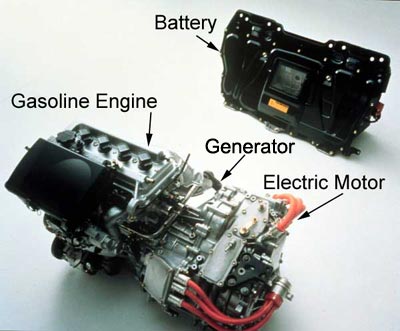 forms a very compact unit that drives the front wheels.
forms a very compact unit that drives the front wheels.
As I mentioned before, the generator that is mounted
to the back of the engine does double duty as a starter motor.
To start the engine, the VVTi system increases valve overlap to
reduce compression. The generator/motor then spins the engine up to
about 1000 rpm. As soon as the engine is spinning up to speed, compression is brought back on line along with spark and fuel
and the engine is running. No typical starter noise, no bucking, no lurching, just a smooth, almost unnoticed transition of
power from electric drive to gasoline engine power.
The diagram below shows how the three components are
connected through the planetary gear (power split device). The
engine is connected to the planetary carrier, the generator is
connected to the sun gear and the output shaft and motor are both
connected to the ring gear.
If there is no load on the generator, then the engine
will simply spin the generator through the planetary gears and not be able to move the car. This is what happens when the selector is in Neutral or Park. If a load is placed on the
generator, either to charge the battery or to directly power the
electric motor, then a portion of the engine's power will be
directed through the planetary gear to the drive wheels to move the
vehicle. By regulating the load on the generator, the engine
RPM can be held constant while accelerating the car, thereby acting
like an infinitely variable transmission. Pretty ingenious,
isn't it?
By adding that second motor/generator and a single
planetary gearset, Toyota was able to completely eliminate the
transmission and still have the effect of a continuously variable
transmission. But what about reverse gear?
Simple. Backing up is handled entirely by the electric
motor.
The following diagrams show the power system for the
Toyota Prius :
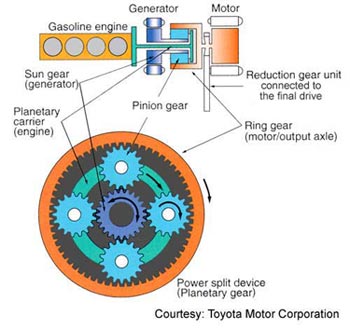 |
The Honda Insight power train is fairly straight forward front-wheel drive arrangement, consisting of a small three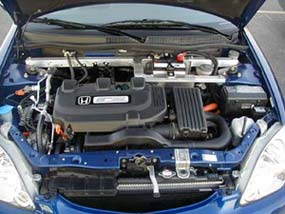 cylinder high-efficiency engine that is coupled to an
ultra-thin electric motor mounted between the engine and either a
conventional 5-speed standard shift transmission or a new
Continuously Variable Automatic Transmission (CVT). The battery is a 144 volt Nickel Metal Hydride (Ni-MH) unit that
contains 120 cells of 1.2 volts each.
cylinder high-efficiency engine that is coupled to an
ultra-thin electric motor mounted between the engine and either a
conventional 5-speed standard shift transmission or a new
Continuously Variable Automatic Transmission (CVT). The battery is a 144 volt Nickel Metal Hydride (Ni-MH) unit that
contains 120 cells of 1.2 volts each.
The Insight has an all-aluminum body structure that is
about half the weight of an equivalent steel body. The total
weight of the Insight is a remarkable 1,856 pounds.
Fuel cells and the
future
Hybrid technology is an interim solution that can
lessen, but not eradicate, our dependence on fossil fuel.
There is another new technology called "Fuel Cells" that should be
available by the end of the decade that will eliminate our
dependence on non-renewable resources.
Fuel cells convert hydrogen and oxygen to electricity
without going through a combustion process; thereby virtually
eliminating emissions. They also operate at much higher
efficiencies than internal combustion engines, producing double the
amount of energy.
Most of the world's auto manufacturers have a fuel
cell project in progress and virtually all of them agree that fuel
cells are the propulsion system of the future.
Honda is saying that by 2010, you should expect
mid-sized sedans with all the trimmings and power that we enjoy
today, fueled by hydrogen that you can produce yourself in your
garage using a Home Energy Station connected to your natural gas supply line. Not only will this Home Energy Station produce
Hydrogen for your fuel-cell car, it will also help to heat your
home.
